While not as simple as opening a can (and certainly not a replacement for good old condensed cream of mushroom), Potato and Leek Soup is a cinch to make, and great to have in the freezer. You can dress it up or down in a wide variety of ways – it’s a new toy every day!
Here’s a little story about recipe writing and chefs and matters of weights and measures. Once upon a time, I was given the honor of chopping onions for famous Canadian Chef Michael Smith, who was visiting Calgary on tour. His recipe called for “half an onion”. The onions purchased in advance to facilitate his presentation were softball-sized lovelies, the likes of which apparently were not common in his kitchen on the east coast. When he viewed the volume of my beautifully chopped “half an onion” and discovered he had about three times as much as he was anticipating, we had to have a little Cross-Canada cultural food chat.
If he had had said “4 ounces of onion, chopped”, or “1/2 cup chopped onion”, we could have saved a little time and confusion. I have written the following recipe with both weights and volumes for those who need precise directions. The short version is: roughly equal parts by weight leeks and potatoes, trimmed, peeled and chopped, with enough broth to float them well, and enough seasoning and dairy to make the finished product taste good. If you understood that, go make some soup and don’t bother reading the rest of this post.
Ingredients:
This is “Big Batch” cooking — the yield is in the neighborhood of 8 cups. As a base ingredient, I like to have lots on hand in the freezer. If your freezer isn’t large, make half a batch. The most efficient way to store it is in small zip-closure freezer bags with all the extra air squeezed out, laid flat until solid, and then “filed” vertically.
- 1 pound (500g) leeks (or about 4 cups when trimmed, roughly chopped, washed and shaken dry)
- 3 Tbsp butter
- Pinch of salt
- 1 pound (500g) Russet or Yukon Gold potatoes (not thin-skinned waxy potatoes – you’ll end up with “glue soup”), or a generous 3 cups of 1.5cm cubes depending on how much peeling you had to do, and whether there were dark spots in the potatoes that had to be eliminated\
- 1 litre chicken or vegetable broth
- 1 cup whipping cream (you can use lower fat cream if you have to, or the no-fat dairy cream product)
- ½ cup milk
- ½ cup Greek (thick) yogurt (not low-fat, or no-fat)
- White pepper (if you have it) or black pepper to taste, and salt to balance flavors
Just a note — low-fat dairy products are more prone to “splitting” than higher fat ones. If the cream and yogurt split, the soup won’t be beautiful, but it will still be edible. There isn’t a whole ton of dairy per serving, so go for quality — you won’t be sorry.
For my lactose-intolerant folk, take advantage of lactose-free milk products if you can. I haven’t tried any of the non-dairy milk products in this recipe myself, but you could try your favorite. Silken tofu can stand in for the yogurt.

…imagine the yogurt…
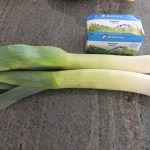
…one pound…


…Sweet and Russet Potatoes…

…trimmed…

I like to use half Russet or Yukon Gold potatoes, and half sweet potato in my soup, when I can find the particular type of sweet potato that I prefer — not those orange “yams”.
What’s the difference between a yam and a sweet potato, you ask?
OK — here comes the lesson. We have a few kinds of sweet potatoes in our markets, although the darker-fleshed ones are often called “yams”. Darker sweet potatoes are wetter and sweeter than the light-colored ones. I like the pale yellow-fleshed, light-skinned ones for this recipe, because they’re drier and starchier. They bring a bit of beta carotene and a bit of extra fibre to the soup, but it’s still delicately flavored and ready to party with a wide variety of additional ingredients. The darker sweet potatoes really benefit from more robust seasoning, resulting in stand-alone soup that isn’t as cooperative in taking on other identities. They work terrifically with carrots, though.
True yams, African in origin, are not often found in the grocery stores I frequent, but I’m sure they would make delicious soup if you could find them.
Method:
Cut the leeks lengthwise, then crosswise into 1cm pieces. Wash well in lots of water, and shake in a colander to dry.
Sweat leeks in butter with a pinch of salt in a saucepan over medium low heat until well wilted, about 5 minutes. “Sweat” just means to soften them, not cook them until they’re brown. Keep an eye on them — they brown without notice, especially if your pan doesn’t have a thick bottom.


Add the potatoes and broth. Bring to a boil, then reduce to a simmer. Cover and cook on very low heat for 45 minutes, until the potatoes are very soft.


Puree the soup with an immersion blender, in a regular blender or a food processor. Work in batches if you need to – no one likes to clean dried potato soup off the ceiling.
You can choose your texture – I like silky smooth but if you’re headed for chowder, you might want to use a potato masher instead of a blender and leave everything just a little lumpy.
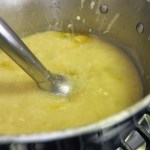

Return the puree to the saucepan.
Add cream, milk and yogurt. Adjust the seasoning with black or white pepper (white pepper has a sharper flavor) and salt. If you used sweet potato, and no-salt broth, you’re going to need quite a bit of salt to balance the flavor. Don’t panic, and don’t give up until the soup tastes wonderful.
The starch from the potatoes will help to stabilize the cream and yogurt, preventing it from “splitting”, or curdling. That being said, I wouldn’t boil the dickens out of the soup once the dairy has been added.


Serve immediately, garnished with chives
— or —
for classic Vichysoise, chill completely and serve cold, garnished with chives (…ooooo – chive blossoms would be lovely in the summer…)
I always thought Vichysoise had cucumber in it. It doesn’t.

Multi-tasking with Potato and Leek Soup
The basic recipe makes lots of soup (8 cups or so). You could make less, but then you wouldn’t have any “heat and eat” meals later on. Portion and freeze in containers or freezer bags.
One cup of this soup is a good basic portion if you’re going to jazz it up. For single servings, you might want to keep some basic information in mind. Canada’s Food Guide says half a cup of cooked veg is a serving, so that’s a good place to start when you’re “adding in”, although I have added as much as a whole cup of broccoli. Considering there is already dairy in the soup, you could add 3 ounces of protein (fish or whatever), to make it a meal. If you add in so much stuff that your soup starts to look like porridge, you might want to thin it with a bit of milk, broth or water.
Broccoli and Cheese Soup
Microwave or steam half a cup of broccoli, or use frozen. Chop it fairly finely. You can simply combine the broccoli and the soup and heat them both together with about a quarter cup of grated cheese, or you can blitz everything together with your immersion blender, or in your Magic Bullet (if it’s still working – did you upgrade to a NutriBullet?) Hold back some nice little spoon-sized broccoli florettes for garnishing, if you have company.

Spinach Soup
Re-heat a cup of potato leek soup. Add as much spinach as you like, either fresh or well-squeezed frozen, and continue heating until the spinach wilts. For really great flavor, a little green onion is a good addition, and a little lemon zest, and some extra pepper. Puree or not, as you choose — it’s pretty either way. I like crumbled feta cheese for garnish. If you want to keep the vibrant color, don’t re-heat it any more than you have to.

Quick Fish Chowder
Chowder is classically thickened with crushed soda crackers or sea biscuit, but I don’t suppose you have any sea biscuit hanging around.
Heat up a portion of the soup and add some seafood – any kind of cooked firm white fish (“planned-over” from your last meal), cooked or raw shrimp (simmer until pink), good old canned salmon or tuna (drained of course), or hot-smoked (barbecue) salmon chunks, drained baby clams, even that extra-special frozen canned lobster or crab if you’re going upscale. Crush up 2 soda crackers per serving and stir them in, or garnish with oyster crackers (or goldfish crackers – whatever you have). This is not “real” chowder, but it’s a great way to put fish on the menu. Add a squeeze of lemon or a little lemon zest, and maybe a shot of Tabasco.

Corn or Vegetable Chowder
Add a half-cup of frozen corn, or any other kind of frozen vegetable you fancy, while you are heating the soup. If you had a leftover roasted little potato or two, this is a good thing to add. Grate in some carrot, chop a little celery – it’s all good. The soup will stand up to some gentle simmering, but you might want to add a little extra water if you are cooking raw vegetables in the simmering soup, to counter the inevitable evaporation.
I like to add a little smoked pork of some kind – garlic sausage, cooked bacon or ham.

Dill Pickle Soup
This is a Polish classic. A friend of mine in Edmonton, who is a very fine cook, introduced me to the concept, and I had some in a restaurant there. All the recipes I have Googled are almost exactly like this very potato and leek soup, but are finished with chopped dill pickle and a little pickle juice. I think a good shake of onion/garlic herb blend wouldn’t be amiss. If this is familiar, there you go. If it’s not, don’t knock it until you’ve tried it.

That should get you started. I haven’t tried it, but if you added cooked noodles, mushrooms, green peas and a can of drained tuna to a cup of this soup, I bet you’d get a decent little Tuna Noodle Casserole. Don’t forget the crushed potato chips on top!
For all you starch-averse folks out there (and you know who you are – you’re the ones who confuse starch with“carbs”): please remember that all foods are good for you in appropriate quantities. Potatoes are a complex carbohydrate with a high glycemic index, so plan accordingly.
And for those who really like to follow food trends, add a whack of kale to this soup and knock yourself out. Cauliflower soup has a whole entry to itself.



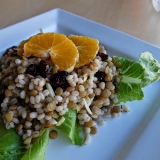
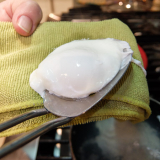
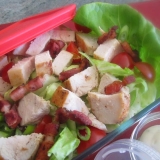
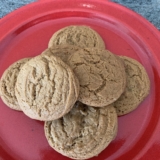
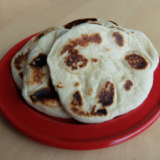
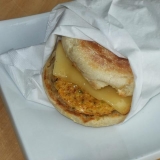
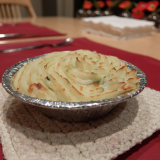
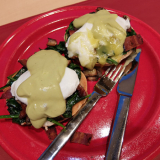
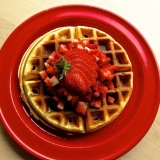
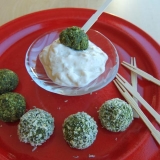

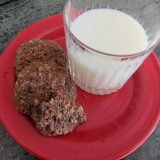
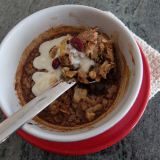
Leave A Comment